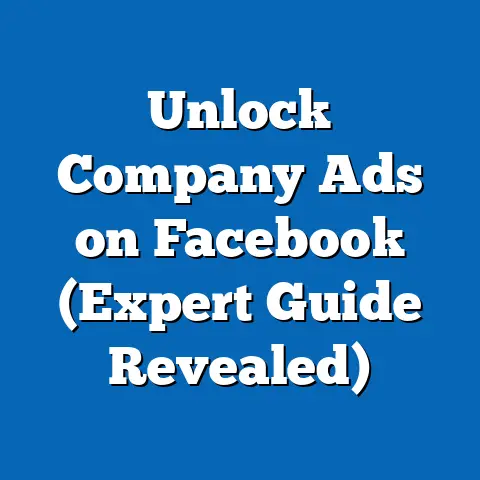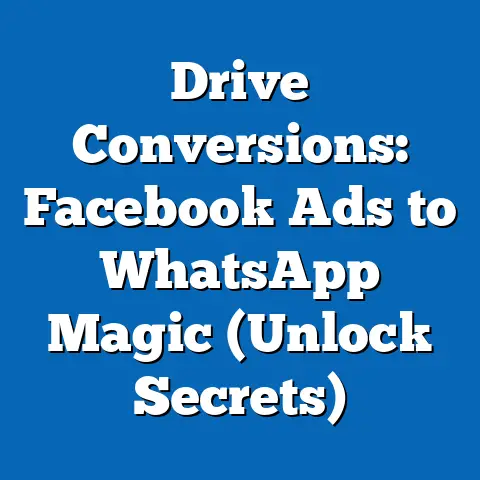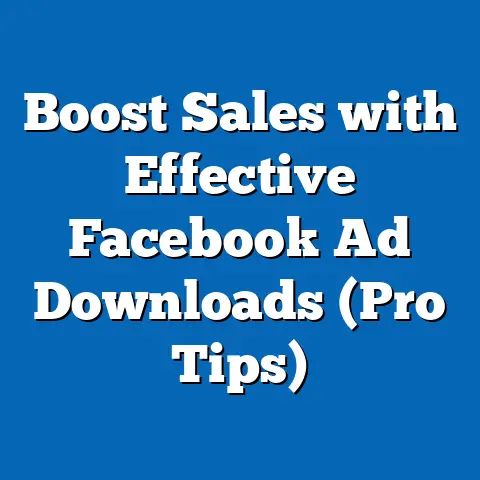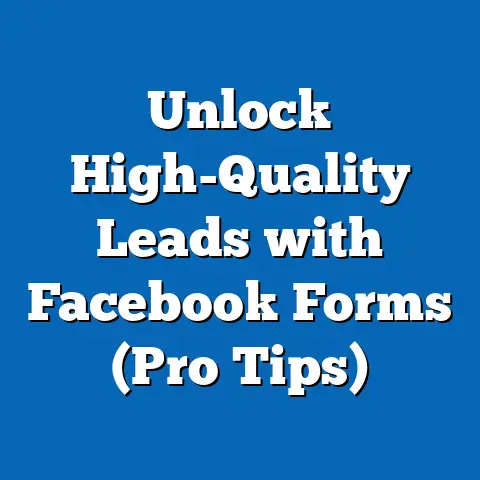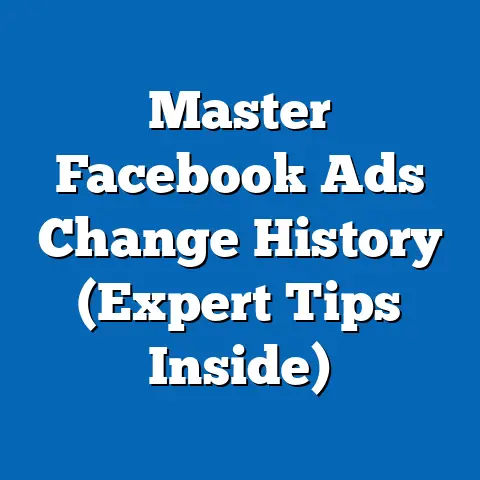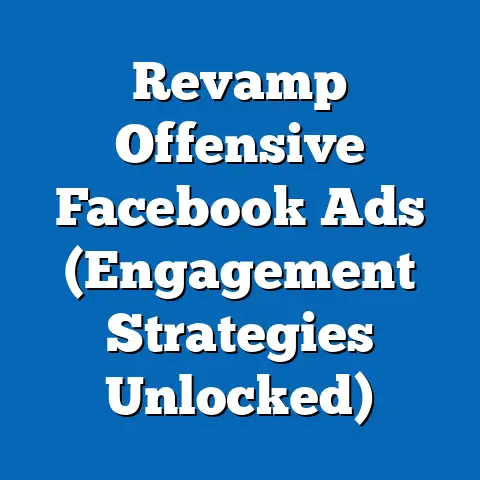Boost Facebook Ads with Quality Insights (Expert Tips)
In the fast-paced world of digital marketing, it’s easy to get caught up in the sheer volume of data available. Many believe that the more data they collect, the better their Facebook advertising campaigns will perform. This, however, is a common misconception. I’ve seen countless marketers drown in a sea of numbers, only to realize that they’re missing the forest for the trees. It’s not about the quantity of data; it’s about the quality of the insights you derive from it.
Think of it like this: having a million puzzle pieces doesn’t guarantee you can complete the puzzle. You need to understand how the pieces fit together, which ones are most important, and how to use them to build the bigger picture. That’s what quality insights do for your Facebook ads. They help you understand your audience, refine your targeting, and craft compelling creatives that drive results.
In this guide, I’m going to share expert tips on how to leverage quality insights to boost your Facebook ads. We’ll dive deep into audience segmentation, ad creative development, Facebook’s ad tools, and key performance indicators (KPIs). By the end of this article, you’ll have a clear understanding of how to turn raw data into actionable strategies that will significantly improve your advertising performance.
Understanding Quality Insights
So, what exactly are “quality insights” in the context of Facebook advertising? It’s more than just knowing the age and location of your audience. Quality insights are the actionable takeaways you get from analyzing your data. They tell you why your audience is behaving the way they are, what motivates them, and what kind of messaging resonates with them.
Think of it as moving beyond simple demographics to understanding your audience’s psychographics – their values, interests, and lifestyles.
There are two main types of data that contribute to quality insights:
- Qualitative Data: This includes information like customer feedback, survey responses, and social media comments. It provides context and helps you understand the “why” behind the numbers.
- Quantitative Data: This includes metrics like click-through rates (CTR), conversion rates, and cost per acquisition (CPA). It provides measurable data that shows you how your ads are performing.
The magic happens when you combine these two types of data. For example, you might notice a low CTR on one of your ads (quantitative data). By analyzing customer feedback (qualitative data), you might discover that the ad’s messaging is confusing or doesn’t resonate with your target audience. This insight allows you to refine your ad copy and improve your CTR.
Quality insights are crucial for:
- Better-Targeted Ads: Understanding your audience allows you to create more precise targeting parameters, ensuring your ads are seen by the people most likely to convert.
- Improved Audience Engagement: When you know what motivates your audience, you can create ads that are more engaging and relevant, leading to higher CTRs and more meaningful interactions.
- Higher Conversion Rates: By understanding your audience’s needs and pain points, you can craft compelling offers and calls-to-action that drive conversions.
Example of Quality Insights:
Let’s say you’re running a Facebook ad campaign for a new line of organic skincare products. Your initial targeting focuses on women aged 25-45 who are interested in beauty and skincare. However, your conversion rates are lower than expected.
By analyzing your data, you discover the following:
- Qualitative Insight: Customer feedback reveals that many people are concerned about the environmental impact of skincare products.
- Quantitative Insight: Ads that highlight the “eco-friendly” aspect of your products have a higher CTR than ads that focus solely on beauty benefits.
Based on these insights, you refine your ad copy to emphasize the sustainable sourcing and packaging of your products. You also create new ad creatives that showcase the natural ingredients and eco-friendly practices. As a result, your conversion rates increase significantly.
Takeaway: Quality insights are the key to unlocking the full potential of your Facebook ads. By understanding your audience and combining qualitative and quantitative data, you can create more effective and engaging campaigns.
Next Steps: Start by reviewing your existing Facebook ad campaigns and identifying areas where you can gather more data. Consider running surveys, analyzing customer feedback, and closely monitoring your ad performance metrics.
The Role of Audience Segmentation
Audience segmentation is the process of dividing your target audience into smaller, more specific groups based on shared characteristics. It’s a crucial step in leveraging quality insights because it allows you to tailor your messaging and targeting to resonate with each segment. I’ve found that generalized ads rarely perform as well as highly targeted campaigns.
Think of it like this: you wouldn’t use the same language and imagery to market a luxury car to college students as you would to retired executives. Audience segmentation allows you to speak directly to the needs and interests of each group.
Here are some common segmentation strategies:
- Demographic Segmentation: This involves segmenting your audience based on age, gender, income, education, and other demographic factors.
- Psychographic Segmentation: This involves segmenting your audience based on their values, interests, lifestyles, and attitudes.
- Behavioral Segmentation: This involves segmenting your audience based on their online behavior, such as website visits, purchase history, and engagement with your ads.
- Geographic Segmentation: This involves segmenting your audience based on their location, such as country, region, city, or zip code.
Facebook Analytics offers a wealth of information that can be used to create effective audience segments. You can analyze data like:
- Page Likes and Interests: What other pages do your fans like? What are their interests?
- Demographics: What is the age, gender, and location breakdown of your audience?
- Purchase Behavior: What products or services are your audience likely to purchase?
- Device Usage: What devices are your audience using to access Facebook?
Expert Tips for Analyzing Audience Insights:
- Look for Patterns: Identify common characteristics and behaviors among your most engaged audience members.
- Create Personas: Develop detailed profiles of your ideal customers based on your audience insights.
- Test Different Segments: Experiment with different segmentation strategies to see which ones perform best.
- Refine Your Segments: Continuously monitor your ad performance and refine your segments based on the data.
Case Study:
A local restaurant wanted to increase its lunch traffic. They initially ran a generic Facebook ad campaign targeting everyone within a 5-mile radius. However, the results were underwhelming.
By analyzing their audience insights, they discovered the following:
- A significant portion of their audience worked in nearby office buildings.
- Many of these people were interested in quick and healthy lunch options.
Based on these insights, they created a new audience segment targeting office workers within a 1-mile radius who were interested in healthy food. They then created a new ad campaign promoting their express lunch menu with a focus on healthy ingredients. As a result, their lunch traffic increased by 30%.
Takeaway: Audience segmentation is a powerful tool for improving the performance of your Facebook ads. By understanding your audience and tailoring your messaging to resonate with each segment, you can significantly increase your engagement and conversion rates.
Next Steps: Dive into your Facebook Analytics and start exploring your audience insights. Identify potential segments and create test campaigns to see which ones perform best.
Crafting Compelling Ad Creatives Based on Insights
Once you have a clear understanding of your audience segments, the next step is to craft compelling ad creatives that resonate with them. This is where your quality insights truly shine. I’ve seen ads that are technically perfect but fall flat because they don’t connect with the audience on an emotional level.
Your ad creatives should speak directly to the needs, interests, and pain points of your target audience. This means:
- Using Language They Understand: Avoid jargon and technical terms that your audience might not be familiar with.
- Highlighting Benefits Over Features: Focus on how your product or service will improve their lives, rather than simply listing its features.
- Using Visuals That Resonate: Choose images and videos that are visually appealing and relevant to your audience.
Expert Tips for A/B Testing Ad Creatives:
- Test One Element at a Time: Change only one variable at a time (e.g., headline, image, call-to-action) to accurately measure its impact.
- Use a Large Enough Sample Size: Ensure that you have enough data to draw statistically significant conclusions.
- Monitor Your Results Closely: Track your key performance indicators (KPIs) to see which creatives are performing best.
- Iterate and Improve: Continuously refine your creatives based on your A/B testing results.
Example of Successful Ad Creative Based on Insights:
A clothing retailer wanted to promote its new line of sustainable denim jeans. They initially ran a generic ad campaign featuring models wearing the jeans in a studio setting. However, the results were underwhelming.
By analyzing their audience insights, they discovered the following:
- Their target audience was highly concerned about the environmental impact of the fashion industry.
- They were drawn to brands that were transparent about their sustainable practices.
Based on these insights, they created a new ad campaign featuring real people wearing the jeans in everyday settings. The ads highlighted the sustainable materials and ethical manufacturing processes used to create the jeans. They also included testimonials from customers who loved the jeans.
As a result, their ad campaign generated a significant increase in sales and brand awareness.
Takeaway: Compelling ad creatives are essential for driving engagement and conversions. By using quality insights to understand your audience and A/B testing your creatives, you can create ads that resonate with your target audience and achieve your advertising goals.
Next Steps: Review your existing ad creatives and identify areas where you can incorporate more audience insights. Consider A/B testing different headlines, images, and calls-to-action to see which ones perform best.
Leveraging Facebook’s Ad Tools for Insight Generation
Facebook provides a suite of powerful ad tools that can help you gather quality insights and optimize your campaigns. I’ve spent years mastering these tools, and I can tell you that they are essential for any serious Facebook advertiser.
Here are some of the key tools:
- Ads Manager: This is your central hub for creating, managing, and tracking your Facebook ad campaigns. It provides a wealth of data on your ad performance, including impressions, clicks, conversions, and cost per result.
- Audience Insights: This tool allows you to learn more about your target audience, including their demographics, interests, behaviors, and purchase habits.
- Facebook Analytics: This tool helps you track user behavior on your website and app, providing valuable insights into how people interact with your brand.
Step-by-Step Guide to Using Facebook’s Ad Tools:
- Set Up Tracking: Ensure that you have the Facebook Pixel installed on your website and app to track user behavior.
- Define Your Goals: Clearly define your advertising goals (e.g., increase website traffic, generate leads, drive sales) and choose the appropriate campaign objective in Ads Manager.
- Create Your Audience: Use Audience Insights to identify your target audience and create custom audiences based on demographics, interests, and behaviors.
- Craft Compelling Creatives: Use your audience insights to create ad creatives that resonate with your target audience.
- Monitor Your Performance: Regularly monitor your ad performance in Ads Manager and make adjustments as needed.
- Analyze Your Data: Use Facebook Analytics to track user behavior on your website and app and identify areas for improvement.
Advanced Features:
- Lookalike Audiences: This feature allows you to create new audiences that are similar to your existing customers or website visitors.
- Dynamic Ads: This feature allows you to automatically show relevant products to people who have visited your website or app.
Expert Tips for Setting Up Tracking and Measurement:
- Use UTM Parameters: Add UTM parameters to your ad URLs to track the source of your website traffic in Google Analytics.
- Set Up Conversion Tracking: Set up conversion tracking in Ads Manager to track the number of leads or sales generated by your ads.
- Create Custom Reports: Create custom reports in Ads Manager to track the KPIs that are most important to your business.
Takeaway: Facebook’s ad tools provide a wealth of data and insights that can help you optimize your campaigns and achieve your advertising goals. By setting up tracking, defining your goals, creating targeted audiences, and crafting compelling creatives, you can leverage these tools to drive results.
Next Steps: Explore Facebook’s ad tools and familiarize yourself with their features and capabilities. Set up tracking, define your goals, and start experimenting with different audiences and creatives.
Measuring Success with Key Performance Indicators (KPIs)
Measuring the success of your Facebook ad campaigns is crucial for understanding what’s working and what’s not. This is where Key Performance Indicators (KPIs) come into play. KPIs are measurable values that demonstrate how effectively you are achieving your business objectives. I’ve seen many campaigns fail simply because the marketers weren’t tracking the right metrics.
Here are some common KPIs for Facebook ads:
- Impressions: The number of times your ad is displayed.
- Reach: The number of unique people who saw your ad.
- Click-Through Rate (CTR): The percentage of people who clicked on your ad after seeing it.
- Conversion Rate: The percentage of people who completed a desired action (e.g., made a purchase, filled out a form) after clicking on your ad.
- Cost Per Acquisition (CPA): The cost of acquiring a new customer through your Facebook ads.
- Return on Ad Spend (ROAS): The revenue generated for every dollar spent on your Facebook ads.
Choosing the Right KPIs:
The KPIs you choose should be aligned with your campaign objectives. For example, if your goal is to increase brand awareness, you might focus on impressions and reach. If your goal is to generate leads, you might focus on conversion rate and CPA.
Expert Tips for Creating Reports:
- Focus on the Most Important Metrics: Don’t overwhelm your stakeholders with too much data. Focus on the KPIs that are most relevant to your business objectives.
- Use Visualizations: Use charts and graphs to present your data in a clear and concise way.
- Provide Context: Explain the significance of your findings and how they relate to your business goals.
- Offer Recommendations: Provide actionable recommendations based on your analysis.
Takeaway: Measuring your success with KPIs is essential for optimizing your Facebook ad campaigns and achieving your business objectives. By choosing the right KPIs, continuously monitoring your performance, and adapting your strategies based on the data, you can maximize your return on investment.
Next Steps: Review your existing Facebook ad campaigns and identify the KPIs that are most relevant to your goals. Start tracking these KPIs and create reports that highlight your insights and performance metrics.
Conclusion
In conclusion, boosting your Facebook ads with quality insights is not just about collecting data; it’s about understanding and analyzing that data to create more effective and engaging campaigns. By focusing on quality over quantity, you can unlock the full potential of your Facebook advertising and achieve your business objectives.
I encourage you to adopt a strategic approach in analyzing your Facebook ad campaigns. Remember to:
- Understand your audience and their needs.
- Segment your audience to tailor your messaging.
- Craft compelling ad creatives that resonate with your target audience.
- Leverage Facebook’s ad tools to gather quality insights.
- Measure your success with KPIs and adapt your strategies as needed.
By implementing these expert tips, you can transform your Facebook ads from a cost center into a powerful engine for growth.
Now, I invite you to implement these expert tips and share your experiences in boosting your Facebook ads. What insights have you found most valuable? What strategies have worked best for you? Share your thoughts in the comments below! Let’s learn from each other and create even more effective Facebook ad campaigns.

